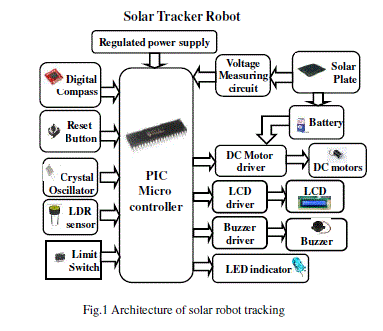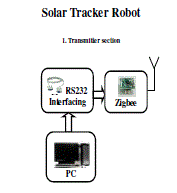ISSN ONLINE(2319-8753)PRINT(2347-6710)
ISSN ONLINE(2319-8753)PRINT(2347-6710)
B.Suchitha Samuel1, B.Bharathi1, J.Mrudula2
|
| Related article at Pubmed, Scholar Google |
Visit for more related articles at International Journal of Innovative Research in Science, Engineering and Technology
Most of the solar powered vehicles are powered using fixed solar panels placed on top of the vehicle, where the solar panel remains in the direction of vehicle irrespective of the direction of the sun. This project provides the best solution for this by aligning the tracker setup continuously toward the sun irrespective of the direction of the robot/vehicle. The project is PIC microcontroller based robot where the base of the robot can move in all directions and tracker-base itself will align the solar panel to track the sun exactly. Intelligent feedback is provided with the help of digital compass for perfect solar tracking. This project does not need any installation since it is portable and can be located in a free space exposed to direct sunlight. The use of solar energy for powering the robot makes the project distinctive. This project is mainly intended to design a mobile robot that is powered by a solar tracking system with an intelligent feedback system. The project is implemented using PIC microcontroller, H-Bridge motor drivers, LDR sensors, and digital compass and a tracker setup.
Keywords |
| Solar Tracker Robot, LDR Sensors, Digital Compass, Solar Panel, H-Bridge Motor Drivers |
INTRODUCTION |
| From many centuries, sun has been the primary source of energy for the globe. In any solar application the conversion efficiency is improved when the modules are continually adjusted to the optimum angle as the sun traverses the sky. A Solar Tracker is a device onto which solar panels are fitted which track the motion of the sun across the sky ensuring that the maximum amount of sunlight strikes the panels throughout the day. |
| The technical improvement together with the need for high performance robots created faster, more accurate and more intelligent robots. The most important part of any robot design is the power supply. In the case of wired robots efficiency isn’t major issue for power supply but for wireless robots, warfield and surveillance robots it is of much importance. As robots become increasingly common and capable, there will be an increasing need for an intuitive system for remotely controlling the robots. In many situations it is advantageous to have the robot tele-operated.The remote control signals can be sent through a wire, through a local wireless system (like Wi-Fi), over the Internet or by satellite. [1] |
| The project focuses on the use of the promising solar energy for powering of the robot with the help of an automatic solar tracking system with an intelligent feedback system. The unique feature of the proposed system is that instead of taking the earth as its reference, it takes the sun as a guiding source. Its active sensors constantly monitor the sunlight and rotate the panel towards the direction where the intensity of sunlight is maximum. [2]The solar panel moves in one axis, rotates from east to west, while the tracker-base of the robot can move in any direction. The orientation of the photovoltaic panels may increase the efficiency of the conversion system from 20% up to 50%. [3]- [6]. |
BACKGROUND OF RELATED WORK |
| As of now there are many projects related to solar tracking system that are proposed to improve it such as the Microprocessor Based Solar Tracking System Using Stepper Motor where the microprocessor is being used to control the tracking system by interfacing with others components. However, it requires external components to implement program memory [8]. A Miniature Solar Tracker was built which is microcontroller based and single- axis tracking system using DC motor. This project is simple, since the tracking system is supported by a tripod [9]. Different Tracking Strategies for Optimizing the Energetic Efficiency of a Photovoltaic System were followed using fuzzy logic neural controller and dual-axis tracing systems[10].They use more electrical and mechanical parts which increase the difficulty and complexity . |
METHODOLOGY |
| This project is mainly intended to design a mobile robot that is powered by a solar tracking system with an intelligent feedback system. In this project, the tracking system of the robot will be controlled by two Light Dependent Resistors (LDRs) placed on the tracker set up. Two PIC Microcontrollers are used one for the tracker and the other for the robot. Limit switches are provided on either side of the tracker to avoid the total rotation of the tracker. Indication is provided through LED’s on reaching extreme limits. The digital compass data will give feedback to the microcontroller which is displayed on the LCD. In the controller part, it consists of PIC16F877A chip, DC motors interfaced to the robot, and LED’s for display. H-Bridge drivers are used in order to tolerate changing power requirements. To control the direction of the robot we are using Zigbee modules one as transmitter and the other as receiver synchronized with a PC. |
| A. System Architecture |
| Whole system includes light sensors, digital compass, limit switches, four DC motors, and H-Bridge motor drivers. Two major parts, from the figure are tracker and the base. The PIC16F877A microcontroller on the control circuit is the main processor which will control the whole system. |
 |
 |
| B. Hardware Description |
| 1) LDR Sensors: To detect the present of sunlight we have used LDR sensors. LDR is a special type of resistance whose value depends on the brightness of the light, which is falling on it. It has resistance of about 1 mega ohm when in total darkness, but a resistance of only about 5k ohms when brightness illuminated. When west cell (W) is in shadow, tracker rotates to east, while when east cell (E) in shadow, tracker will rotate to west [7]. |
| 2) Solar Panel: A solar cell or photovoltaic cell is a device that converts solar energy into electricity by the photovoltaic effect. The collection of solar cells is called a solar panel or solar array. Solar panel is placed on top of the tracker board which absorbs the maximum sunlight which is used as supply to the motors or stored in the battery for future use. |
| 3) Digital Compass (HMC6352): The HMC6352 is a fully integrated compass module that combines 2-axis magnetoresistive sensors with the required analog and digital support circuits, and algorithms for heading computation. The HMC6352 communicates via a two-wire I2C bus system as a slave device. The digital compass provides the feedback to the robot with respect to the tracker. |
| 4) Microcontroller (PIC16F877A): PIC16F877A from Microchip is a single microcontroller which is very easy to be assembled, programmed and also the price is very cheap. One unit of PIC16F877A microcontroller can be programmed and erased so many times.PIC includes features for entire analog as well as digital form of operations. Two PIC microcontrollers are used in the project. It plays a major role as the coordination between different components in the circuit is maintained by the microcontroller. |
| 5) Zigbee: Zigbee is a wireless technology developed as an open global standard to address the unique needs of lowcost, low-power, wireless sensor networks. This network is one of the widely used open source wireless network available in the market. In the project we use Zigbee (RF Transceiver). The PC provides the information to the Zigbee module. The Zigbee at the robot receives the command and microcontroller (on board computer) controls the direction respectively. |
| 6) DC Motors: A DC Motor is a mechanically commutated electric motor powered from direct current (DC). Modern DC motors are often controlled by power electronics systems called DC drives. H-Bridge circuits are often used in robotics and other applications to allow DC motors to run forwards and backwards. H bridges are available as integrated circuits, or can be built from components. The H-bridge arrangement is generally used to reverse the polarity of the motor. |
RESULTS |
| The project is designed such that the solar powered robot/vehicle with tracker set up using DC motor; limit switch and LDR sensors is controlled using the PC successfully. The robot when placed in the sunlight since morning to evening, the tracker could track the maximum sunlight and the power obtained through it could be used to operate the robot according to the commands given through the PC. |
CONCLUSION |
| Based on the results, the objective of developing the project has been achieved. Integrating features of all the hardware components used have been developed in it. Presence of every module has been reasoned out and placed carefully, thus contributing to the best working of the unit. Secondly, using highly advanced IC’s with the help of growing technology, the project has been successfully implemented. The project demonstrated that implementing solar tracking on mobile robots can be done successfully. Thus the project has been successfully designed and tested. |
FUTURE SCOPE AND RECOMMENDATIONS |
| In future we can use this project in several applications by adding additional components to it. The project can be extended by using sensors which detects any leakage of LPG gas, smoke or any fire and alerts the user through alarm. It can be used for warfield and monitoring applications in far off areas. The solar tracking robot involves wired connections which makes it water sensitive. It can be made more powerful by more mechanical advancements. |
ACKNOWLEDGEMENT |
| I extend my sincere thanks to the Head and all the faculty members of our department for giving me the technical assistance for carrying out the study. My truthful appreciation is to my co-author who has helped me in preparing this paper. |
References |
|